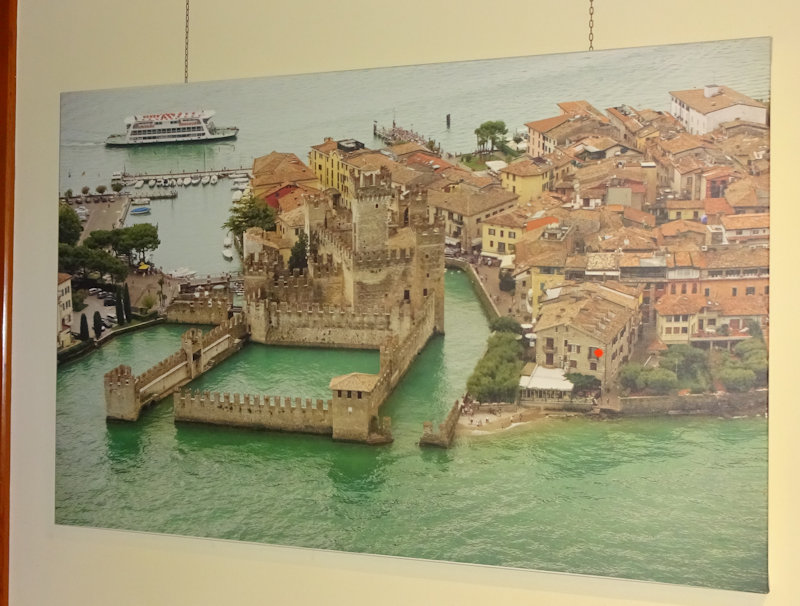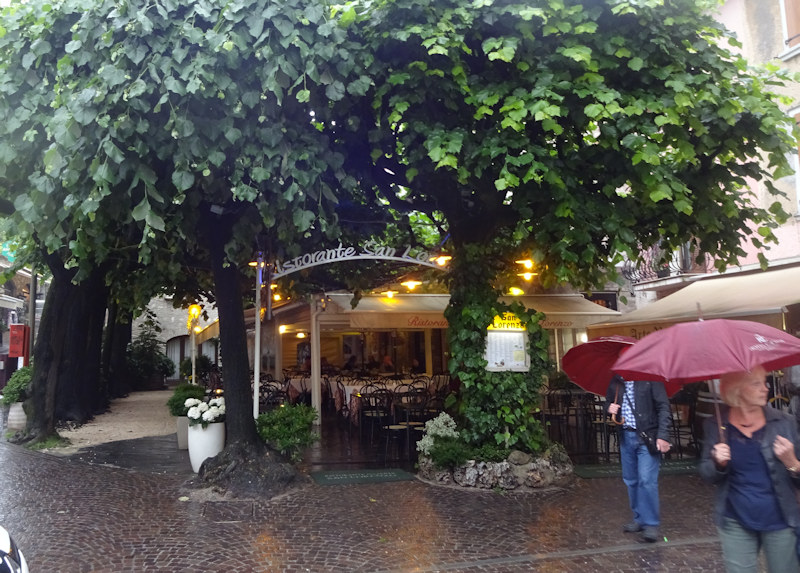|
 Dwight Peck's personal website Dwight Peck's personal website
Sirmione and the neighborhood, May 2016
Ten days in the home of the Scaligeri and the heretics
You may not find this terribly rewarding unless you're included here, so this is a good time for casual and random browsers to turn back before they get too caught up in the sweep and majesty of the proceedings and can't let go.
Walks round Sirmione in the rain

The Squirrel greets the day, 11 May 2016

A peek out the window at the early risers below, and another rainy day

An aerial photo in the breakfast room -- the Castello Scaligero was intended to protect the Della Scala fleet on its Lake Garda patrols, to collect the custom duties for commercial traffic, and to defend the peninsula and town from attackers [and to protect the Scaligeri garrison from the locals, if required]. Our wonderful hotel is the Hotel Grifone (griffin), and our present room's got a red dot on it.

The front door of the Hotel Grifone

Raining on the church next door, the late 15th century edition of the Chiesa di Santa Maria Maggiore -- built over a Lombard church of St Martin from the 8th century (apparently the one founded by Queen Ansa, wife of Desiderius, the last Lombard king, who was ungently removed by Charlemagne in 774), the successor church was integrated into the Scaligeri city walls, with renovations that were completed in about 1510.

The front porch of Santa Maria Maggiore

The front porch was added in the 17th century, using scavenged columns and a Roman milestone bearing the name of Julian the Apostate

An interesting interior, a single room divided into three spans by arches, with a polygonal apse, evidently a common design in the Po valley in the 15th century

The chancel in the apse, at the east end of the church


Most of the frescoes date from the early 15th century, with some along this north wall somewhat earlier.

St Sebastian, characteristically unflappable

Saint Rocco, flaunting his attractive buboes

Excellent. Now back out into the rain.

The medieval town of Sirmione lies perched out near the end of a 4km peninsula protruding from the southern end of the Lago di Garda, Italy's largest lake, in the province of Brescia in Lombardy. It's obviously a strategic location and shows signs of habitation from the 6th millennium BC onward; communities built on stilts were occupied here in 3rd and 2nd millennia BC.

In the Piazza Flaminia. The Roman elites vacationed here from the important city of Verona nearby, and in the first century BC the family of Catullus the poet had a villa here (then called Sirmio), of which, according to one of his poems, he was very fond ("jewel of islands and of peninsulas").

The site served as a fortified base throughout the late Roman period, and was a district capital under the Lombard rulers based in Pavia, from the late 6th to the late 8th century AD. It was capable of assisting in the defense of the southern end of Lake Garda, the route over the Brenner Pass from Austria down the Adige river through Verona, and the fertile lands southward down the Mincio towards Mantua, or Mantova.

The Galleria Civica Dante Alighieri, whatever that means, arching over the single main road through town, predictably the Via Vittorio Emanuele. Sirmione was presumably a free commune by the early 12th century, but in the early 13th century it would have fallen under the obedience of the reputedly vile Ezzelino III da Romano, who allied with the Emperor Frederick II in his campaigns to subject the northern Italian cities and got confirmed in his rule over Verona, Vicenza and Padua. Ezzolino died in 1259, and the Veronese Council elected Mastino della Scala as podestà, and when in 1262 he failed of re-election, Mastino got himself named Verona's Capitano del Popolo by the people's party, and commander of the city's troops, and just settled in as the new normal.

A castle is mentioned in earlier records, but the Scaliger Castle (or Castello Scaligero, or Rocca Scaligera) was begun in about 1277, evidently by Mastino I himself, Capitano del Popolo and effective ruler of Verona and the surrounding territories. An uncommon example of a fortified harbor, the castle is placed about 1km from the northern end of the peninsula and cuts it in two, so that entrance into the town can only be obtained through one of two drawbridges (the other of which leads directly into the castle). The fleet of Scaligeri lake patrol boats, for defense and customs-collecting purposes, could be brought in within the walls of the castle at a need, as we will see presently.

The lake ferry Mantova, which we may or may not get a ride on in a few days' time (nope, we got the Trento)

Along the Via Vittorio Emanuele

A kind of mini-mall and the restaurant Arcimboldo, named after that guy who painted portraits made up of fruits and vegetables

Pensive

The Ristorante San Lorenzo, where as it turned we ate nearly every night during our stay

Traffic on the main drag

This is a lakeside walkway towards the end of the peninsula, to the Roman remains up on the bluff.

The "Grotte di Catullo" on the bluffs at the northern end of the peninsula is neither a grotto nor associated with Catullus, though the poet is known to have had a family villa in Sirmione in the 1st century BC. This thing, a fancy villa or perhaps a thermal baths complex (there are hot springs here, and a modern thermal spa), dates from the mid-2nd century AD.

The villa (presumably)


Archaeological scenes


Reconstructions

-- Jump.

-- Listen up!



More archaeological scenes

The back door


Kristin in the rain

Villa supports

Patience

Back to the Hotel Grifone. Tomorrow's another day.
      
     
  

 Feedback
and suggestions are welcome if positive, resented if negative, Feedback
and suggestions are welcome if positive, resented if negative,  .
All rights reserved, all wrongs avenged. Posted 14 July 2016. .
All rights reserved, all wrongs avenged. Posted 14 July 2016.
|
 Dwight Peck's personal website
Dwight Peck's personal website










































